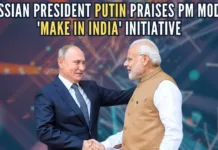
[dropcap color=”#008040″ boxed=”yes” boxed_radius=”8px” class=”” id=””]T[/dropcap]he Modi government’s announcement of allowing 100 per cent FDI in defence via the approval route is a game-changer. With this one move, the government has given a boost to job generation and cleared hurdles in the ‘Make-in-India’ campaign for defence acquisitions.
FDI in defence was last hiked from 26 per cent to 49 per cent in FY 2014-15, but that hardly made a difference to the FDI inflows in the defence industry. Removal of this cap is a blessing for the defence forces which need cutting-edge military technology with adequate indigenisation.
While the government is facing flak from RSS affiliates as well as the opposition, the increase was definitely warranted. Nor have the critics been able to offer valid objections. As India imports nearly 70 per cent of its defence equipment, this policy could not have come at a more appropriate moment. There will be huge foreign exchange savings in the long run.
The charge that the government has sold out to foreign companies is ludicrous. India’s military-industrial complex lacks technology and needs to enter into agreements with foreign defence industry players. Evidently when it comes to hi-tech equipment, the technology provider or original equipment manufacturer (OEM) never likes to have the minority stake.
The change would allow OEMs to enter the Indian market at an increased pace as they would no longer require extensive negotiations with Indian firms. As all such investments would be approved, there can be no flooding of the Indian market by sub-standard foreign equipment.
A case in point would be the French company DCNS that submitted a proposal in May for an investment bid that would involve design, research, development and manufacturing of Air Independent Propulsion (AIP) systems for submarines. This would now most likely get a go-ahead from the government.
The Three Fighters
[dropcap color=”#008040″ boxed=”yes” boxed_radius=”8px” class=”” id=””]C[/dropcap]urrently, one of the largest acquisitions stuck in a limbo is that of the M-MRCA for the Indian Air Force. What had started out as a decade-long search for 126 M-MRCAs ended up in a direct government-to-government deal for 36 Dassault Rafale fighters after Prime Minister Modi’s visit to France. This has since been stuck at the contract negotiation stage due to pricing issues. Sensing the setback in talks and well aware that the IAF would require anywhere between 90-120 fighters even if this deal went through, Lockheed, SAAB and Boeing have already placed their offers.
Swedish giant SAAB has in the meantime offered its Gripen fighter jet to India, including its newly unveiled Gripen E. The Swedish major has also extended its hand to partner with the Make-in-India programme, and to sweeten the deal, it has offered to partner with Hindustan Aeronautics Limited (HAL) to help develop the Tejas Mk1A fighter.
SAAB has also stated that the Gripen has the lowest life-cycle costs in the world and while outlining SAAB’s plans in India, the company has said, “We are talking about true technology transfer under Make In India. We are willing to give India comprehensive system & software control. To be successful we need to work hand in hand with the Indian and Sweden government.” It went a step further saying that it would even upgrade the Gripen every few years so that the IAF has the latest technology, effectively suggesting a very long-term commitment to India, including possibly in the HAL AMCA programme.
Lockheed Martin has offered its legendary F-16 fighter to India, coupled with an offer to setup an entire production line, making it essentially a Made in India F-16. This would be the F-16 Super Viper. The sweetener in this deal would be the price as Lockheed would no longer be seeking any ‘development costs’ for its 40 year old design. That would also be the deal-breaker.
[dropcap color=”#008040″ boxed=”yes” boxed_radius=”8px” class=”” id=””]I[/dropcap]t would make no sense for the IAF to choose a fighter it had earlier rejected in the M-MRCA trials, let alone a fighter design that took to the skies 40 years ago. It would’ve been different had the F-16 already been in IAF service and this been merely a supplementary order. Alas, that is not the case; the IAF is looking for a fresh induction of fighters to take it to the 2030s.
Also, one must keep in mind that Lockheed Martin is the producer of the F-35 Joint Strike Fighter, a machine that can be touted as a fat-bellied nightmare, which experts say, “can’t turn, can’t climb and can’t run.” The defence establishment would do well to junk the offer for the F-16 as this could in future influence decision-making towards the F-35.
The third offer is from Boeing Corporation for the development of the F/A-18 Super Hornet for the Indian Air Force. At a recent event marking the ground-breaking of the Boeing-Tata JV to produce fuselages for the AH-64 Apache, Defence Minister Manohar Parrikar announced that fighter jets would be a part of Make-in-India. However, as he was sharing the dais with a senior Boeing company official, he remained neutral and said he would not commit anything for the F/A-18. Media reports from early 2016 onwards however, indicate a high probability of the joint production of the fighter. The F/A-18 had taken part in the M-MRCA trials but was rejected along with the Eurofighter Typhoon and Russian MiG-35.
Notably, the F/A-18 also has a carrier based version which boasts of being the core of the US Navy. Incidentally, things could sway in favour of the F/A-18 as talks are also underway for India to obtain key aircraft carrier technology from the US. In that case, a naval version may be produced for India and the next Indian Navy carrier may not be seen with MiG-29Ks.
[dropcap color=”#008040″ boxed=”yes” boxed_radius=”8px” class=”” id=””]T[/dropcap]he government could also consider proposals, if any, from Moscow, which had expressed willingness to transfer technology of line replacement units of the Sukhoi-30MKI last year; we also need a S-400 deal. Moscow had pitched the MiG-35 in the M-MRCA too and MiG-29Ks will be arming (along with LCA Navy) the foreseeable future of the Indian Navy’s carrier borne fleet. The MiG-35 has been developed from the MiG-29 and the IAF would be able to induct it with ease. Added to that, the Russians had offered key Transfer of Technology for the MiG-35 way back in 2009.
Of course, this puts the government in a tough spot. It has a big task ahead of it and must be very careful in making this decision. Let’s not forget the original time table for inducting the M-MRCAs has been pushed continuously and we’re approaching the time table of the Tejas Mk2, the HAL AMCA, and the Indo-Russian FGFA, to lead us into 2030. The chosen Make-in-India fighter will, along with the Sukhoi-30MKI, support these aircraft.
All in all, the new FDI in Defence policy will earn laurels for the Modi government on the job creation front (Make-in-India and Skill India) and will fill the serious shortages faced by our forces. Prime Minister Modi is aiming to make India a global defence centre and visions an India that exports defence equipment. This is a giant leap in that direction.
The author is a freelancer, he tweets at @therijuluppal
- Kejriwal: Mirage of a Revolutionary - August 18, 2017
- Swachh Bharat lacks both infrastructure and Swachh mind-set - July 10, 2017
- Need for AFSPA in West Bengal - January 27, 2017











Riju Singh Uppal,appears as a promising writer whose optimism can turn the impossible into the possible.
The tasks ahead pertaining to Defence equipment selection ,purchase and manufacture as the author himself points out is challenging ,nonetheless with this well researched ,focussed analysis of how PM’s ‘Make in India’ dream plan can be brought to reality,with FDI as the booster dosage to skill enhancement efforts in the country,the pessimism can be put to rest.. Congratulations Riju for stepping into the world of journalism which currently seems to be forgetting that it ought to set out to bring in sanity in nation building, bereft of commercial interests.